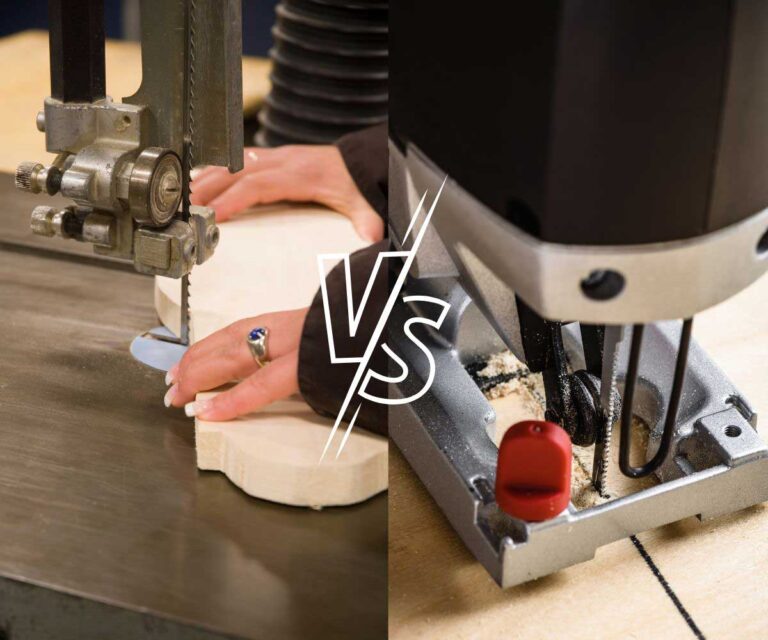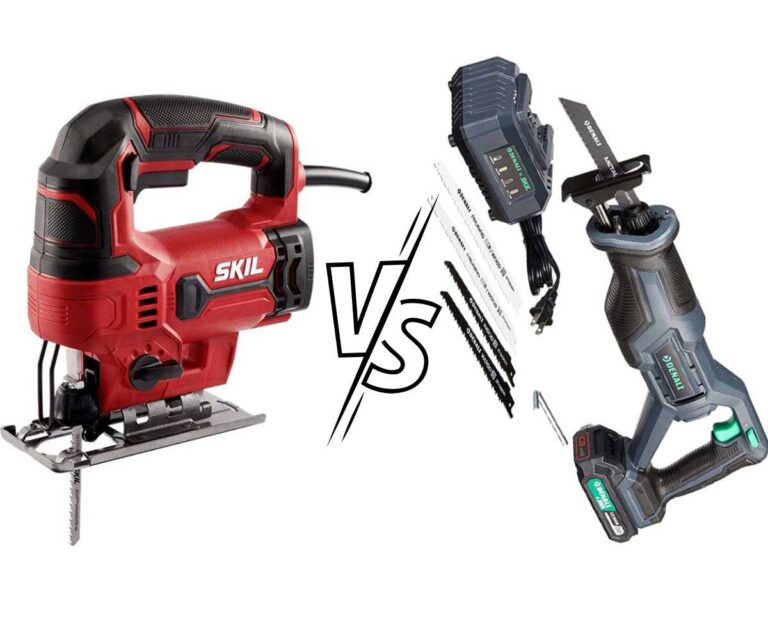Jigsaw vs Circular saw – Which One Should I Choose?
As an Amazon Associate I earn from qualifying purchases.
Jigsaws and circular saws are popular power tools commonly used in woodworking and construction projects. They do have some similar features, but they serve different purposes and have unique features.
A jigsaw is more versatile; use narrow, straight blades to perform straight, curved, angled, or flat patterns and designs at a low cost. In contrast, a circular saw uses round blades and, with a powerful motor, makes faster straight, rip, and bevel cuts in long and small materials.
Let’s compare Jigsaw vs Circular Saw and explain their benefits and drawbacks, as well as their strengths and limitations so that you can pick one easily according to your project’s specific needs and budget.
Contents
Comparison Table between Jigsaw and Circular saw
| Features | Circular saw | Jigsaw |
| Generate power | Up to 15amp | Up to 7.2amp |
| Speed | Faster up to 7000 RPM | Slower 500 to 3500 SPM |
| Blade type | Multiple types | T-shank and U-shank |
| Main purpose | Straight line and plunge cut | Cutting and shaping |
| Power supply | Corded and cordless | Corded and cordless |
| Cut quality | Rough | Smooth |
| Complicated cuts | No | Yes |
| Straight cut | Better | Average |
| Deep cut | Less deep | Deeper |
| Round edges | No | Yes |
| Changing blades | Easy | Easy |
| Weight | More | Less |
| Safety | Average | Better |
| Burn | More | less |
| Portable | Yes | Yes |
| Price | Costly | Affordable |
Pros and Cons Between Circular saw and Jigsaw
Circular saw
This handheld power tool uses round blades and a more powerful motor that spins the blade faster in an upward stroke to cut every possible material, such as wood, metal, plastic, and tile.
A circular saw comes in different types and designs, such as worm drive, sidewinder, and hypoid saws, and is available in both corded and cordless versions, allowing you to work anywhere.
Jigsaw
A jigsaw is similar to a circular saw in that it has a handle, a trigger, and an adjustable base plate and cuts the same materials. But the thing is, a jigsaw uses narrow, straight blades that move the blade up and down and can be used for different types of cuts, such as more curved, angled, or flat patterns and designs.
Like the circular saw, it is portable and available in both corded and cordless versions, allowing you to work anywhere.
Differences between Jigsaw and Circular saw
Weight and size
A jigsaw is more compact, making it lighter and smaller in size than a circular saw. For that, you can hold it for a long time while working. On the other hand, a circular saw, like a jigsaw, is easily portable to carry in workplaces despite its larger size and weight.
Note: There are compact circular saws available on the market, like a jigsaw.
Power
A circular saw features a more powerful output motor, reaching up to 15 amps. On the other hand, a jigsaw has a motor that can be up to 7.2 amps, making the circular saw more powerful and capable of running faster.
Note: Though a jigsaw is comparatively less powerful, it gives more precise cuts than a circular saw.
Cutting speed
For better power, a circular saw runs faster, up to 7000 RPM, and a jigsaw can be up to 3500 SPM. For quick cuts and accuracy, a circular saw is more preferable than a jigsaw.
Blade type
A jigsaw uses two types of different sizes and teeth blades: A T-shank and a U-shank. On the other hand, a circular saw employs blades of various diameters, such as flat top grind, alternate top bevel, combination ATBR, tiple-chip grind, continuous rim, and turbo-rim.
Blade size
A jigsaw and a circular saw mostly use similar-sized blades. A jigsaw uses narrow, straight (3 to 10-inch) blades, and a circular saw uses round-diameter blades; depending on the saw’s size, it can be 10.25 inches long.
Blade change
It is simpler to change the blades on both. On a circular saw, press the spindle lock button and unscrew the bolt, and in a jigsaw, unscrew or click the spring-loaded clamp to change the blade. On both, reverse the process to attach the blade.
Depth of cuts
Though the blade size is similar on a jigsaw and circular saw, depending on the saw size, blade, and 90° angle, a circular saw can cut up to 3-13/16 in. deep, and a jigsaw can cut up to 6 in. deeper than a circular saw.
The advantage is that on a circular saw, you can adjust the depth of cutting, which you do not get in a jigsaw ( only some jigsaw models have that adjustment feature)
Usage
A jigsaw is mainly used to make straight lines, angled lines, curves, shapes, and flat pattern cuts. In contrast, a circular saw is mainly used for long straight cuts, rip cuts, bevel cuts, miter cuts, cross cuts, and plunge cuts.
Cuts
By choosing the right blade and tooth configuration, both tools can cut almost the same material, such as wood, plastic, metal, masonry, and ceramic tile. But the cuts will be more precious on a jigsaw, and the cuts you get on a circular saw will be faster and have greater accuracy.
Versatility
A jigsaw is more versatile than a circular saw. Though both have portability, a jigsaw is lighter and smaller, is easily moveable and holdable in the hand while cutting, and can do all the jobs accurately that a circular saw does.
Accuracy and efficiency
A circular saw has more accuracy and efficiency than a jigsaw, as the circular saw spins the blade faster and, with great consistency, cuts quicker and even handles heavy-duty work better.
A circular saw is ideal for long straight, and rip cuts, whereas a jigsaw is better for curved or irregular cuts.
Safety
Though both have a base plate or guard around the sharp blade for protection, a jigsaw is competitively safer. Because the circular saw blade moves upward in a single stroke, it can easily become stuck with the material, and the kickback or bounce-back effect can cause accidents at high speeds.
Even the jigsaw blade moves up and down, but the kickback has little effect at lower speeds.
Maintenance
A circular saw generally has more complex maintenance requirements than a jigsaw in terms of size and design.
Price
The price of a jigsaw and a circular saw varies according to brand. Spending around $50 to $200, you will get an average to good quality jigsaw, and around $100 to $350; you will get an average to good quality circular saw.
Which One should I choose: Circular saw or Jigsaw
If you are looking for a saw that has great power, accuracy, and efficiency in handling heavy-duty tasks like thick and hard materials to make straight, rip, bevel, and crosscuts on a large sheet of wood, lumber, and other materials, then choose a circular saw.
But if you are looking for a saw that is versatile, powerful, and better for making straight lines, angled lines, curves, irregular shapes, intricate cuts, and flat pattern cuts in a precious manner.
Also, at a low price than a circular saw, a jigsaw can perform all the tasks a circular saw can do; for that, you can choose a jigsaw.
Frequently Asked Questions
How thin a circular saw can cut?
Depending on the blade size and adjusting the base plate, you can set the depth of cutting and set it as low; you can cut around 1/8-inch thin material on a circular saw.
How thick a 5 ¼″ and 7 ¼″ circular saw can cut?
A circular saw comes in different sizes and blades, and also you can adjust the depth of cutting. On a 5 ¼″ circular saw at a 90-degree angle, you can cut 1 ¾″ (1.75 inches) deep, and at 45 degrees, it will be 1 3/16″ (1.1875 inches) deep.
Like this, on a 7 ¼″ circular saw at a 90-degree angle, you can cut 2 ½″ (2.5 inches) deep, and at 45 degrees, it will be 1 13/16″ (1.1875 inches) deep.
Can I cut a circle in wood with a jigsaw?
Yes, you can easily make a circle with a jigsaw. As a jigsaw has narrow, straight blades, it can be used for making circles. You just have to draw a circle on the material and run the jigsaw through the line slowly to have a perfect one.
Why does my circular saw burn the wood?
Yes, cutting with a dull or dirty circular saw blade can burn the wood. A jigsaw uses a powerful motor and runs at a very fast speed that generates quite a good amount of heat, and when a dull or dirty blade touches the surface of the wood, that causes friction, which generates more heat and burns the wood.
Conclusion
Both jigsaws and circular saws are useful power tools that have their own unique advantages and disadvantages. Jigsaws are great for making intricate and precise cuts in a variety of materials, while circular saws are best for making straight cuts in large pieces of wood.
Nevertheless, I have described all their capabilities, working perspectives, and usage. Both are good and useful for their specific cutting capabilities. To achieve a better result, you must now choose one that is appropriate for your project. Thank you.






